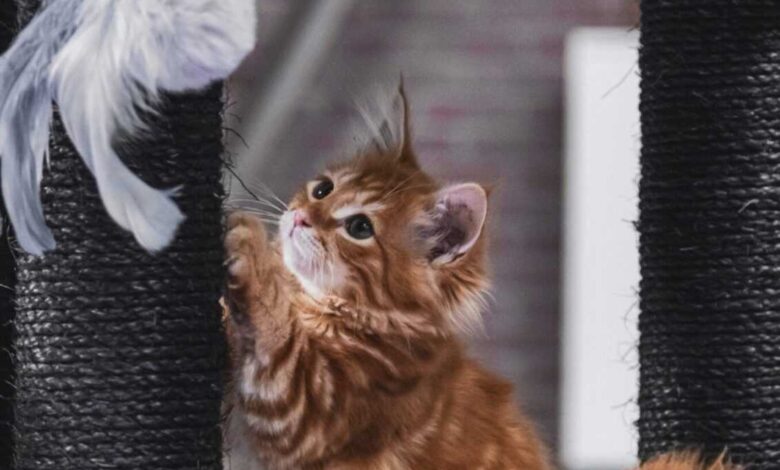
Cats are renowned for their charming quirks, but one behavior that often leaves pet owners scratching their heads (pun intended) is, well, scratching. While scratching is a natural instinct for cats, it can become a problem when furniture and belongings bear the brunt of those sharp claws. Fear not, for in this guide, we’ll delve into cat scratching solutions that not only preserve your precious possessions but also redirect your feline friend’s scratching instincts in a positive way.
Understanding Cat Scratching Behavior
The Natural Need to Scratch
Scratching is hardwired into a cat’s DNA. It serves multiple essential purposes:
- Nail Maintenance: Scratching helps cats shed the outer sheaths of their claws, keeping them sharp and healthy.
- Stretching and Exercise: Cats use scratching as a form of stretching and physical activity, vital for their well-being.
- Territory Marking: When cats scratch, they leave both a visual mark and a scent, establishing their territory.
Identifying the Root Causes
Scratching can be prompted by various reasons, such as:
- Territorial Marking: Cats may scratch to mark their territory, especially in multi-cat households.
- Stress Relief: Stress or anxiety can trigger excessive scratching as a coping mechanism.
- Boredom: Cats left alone for long periods may scratch out of sheer boredom.
Redirecting Cat Scratching
Providing Cat Scratching Posts
Cat scratching posts are a tried-and-true solution. Here’s how to make them effective:
- Choosing the Right Type: Select posts made of materials that appeal to your cat, such as sisal, cardboard, or carpet.
- Strategic Placement: Position scratching posts near your cat’s favorite scratching spots or close to their resting areas.
- Positive Reinforcement: Encourage your cat to use the posts by sprinkling catnip on them or playing near them.
Cat Scratching Cardboard
Cardboard scratchers are a popular choice for felines. They offer several advantages:
- Texture Attraction: Cats are drawn to the rough texture of cardboard, making it a desirable scratching surface.
- Affordability: Cardboard scratchers are cost-effective and easily replaceable when worn out.
- Variety: They come in various shapes and sizes to suit your cat’s preferences.
Exploring Cat Scratching Alternatives
If your cat isn’t interested in traditional scratchers, consider these alternatives:
- Horizontal Scratchers: Some cats prefer scratching surfaces positioned horizontally, like flat cardboard scratchers or mats.
- Cat Trees: Cat trees with integrated scratching surfaces and cozy spots for lounging can be enticing.
- Wall-Mounted Scratching Posts: These space-saving options allow cats to scratch vertically.
Cat Scratching Training
Positive Reinforcement
Training your cat to scratch appropriate surfaces involves using positive reinforcement techniques:
- Rewards: Reward your cat with treats, praise, or play when they scratch in the right places.
- Redirect Gently: If you catch your cat scratching furniture, redirect them to a scratching post without scolding.
- Consistency: Be patient and consistent in your training efforts.
Using Cat Scratching Deterrents
Deterrents can discourage cats from scratching where they shouldn’t:
- Sprays and Repellents: Cat-safe sprays with scents cats dislike can be applied to furniture.
- Double-Sided Tape: Placing double-sided tape on furniture can make it an unpleasant scratching surface.
- Furniture Covers: Use covers or protectors on valuable furniture pieces.
Tailored Solutions for Specific Situations
Cat Scratching in Apartments
Apartment-dwelling cats may need extra attention:
- Vertical Space: Utilize vertical spaces like cat shelves and wall-mounted scratchers.
- Interactive Toys: Provide interactive toys to combat boredom.
Cat Scratching in Shelters
Cats in shelters often need comfort:
- Cozy Hiding Spots: Create secure and cozy spaces for shelter cats.
- Socialization: Encourage socialization with volunteers to reduce stress.
Cat Scratching in Multi-Cat Households
Harmony among multiple cats can be maintained with:
- Multiple Scratching Posts: Ensure each cat has access to their own scratching post.
- Space Segmentation: Create separate spaces for each cat to reduce territorial conflicts.
Reviews and Recommendations
Cat Scratching Post Reviews
Discover top-rated cat scratching posts and learn from user reviews.
Cat Scratching Deterrent Reviews
Explore effective deterrent products and their user feedback.
Cat Scratching Solutions
Cat scratching is a natural behavior that can be redirected and managed with the right approach. By understanding the root causes, providing suitable scratching alternatives, and employing positive reinforcement and deterrents, you can create a harmonious living space for you and your feline companion. With these cat scratching solutions, you can keep your furniture intact and your cat content, allowing both of you to enjoy a scratch-free coexistence.
Remember that patience and consistency are key when implementing these solutions. Each cat is unique, so adapt these strategies to your cat’s preferences and needs.








